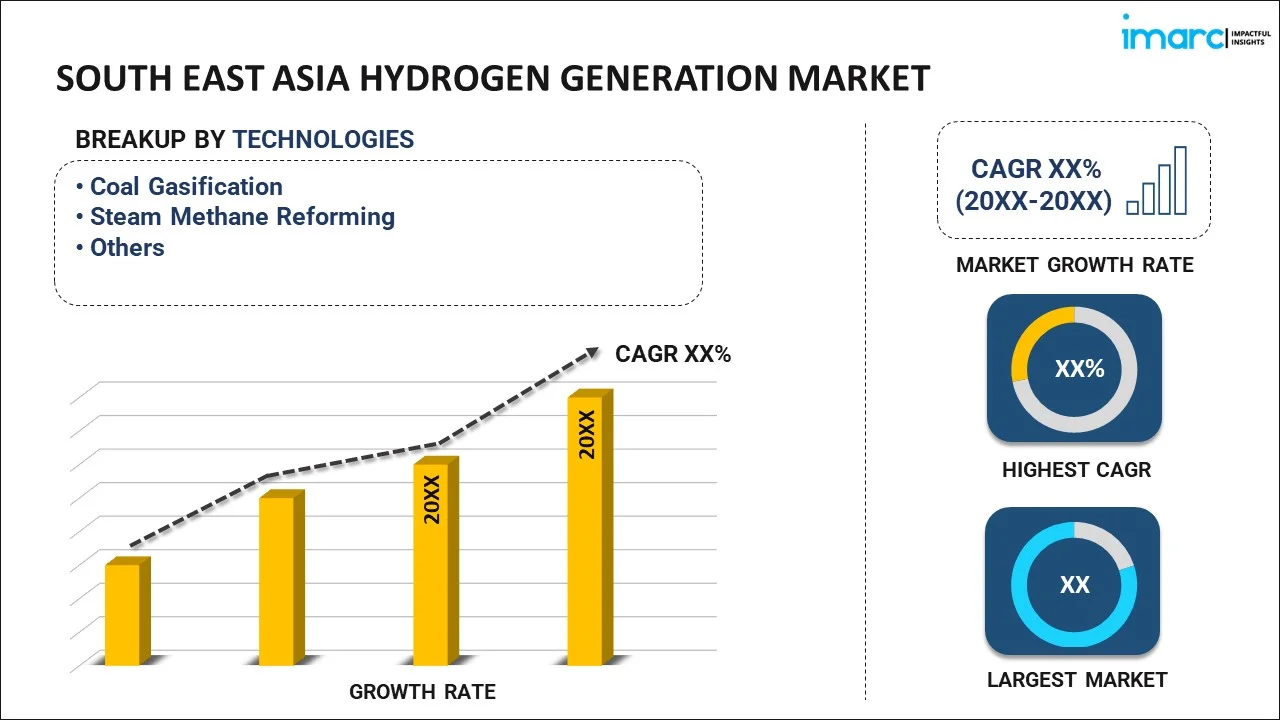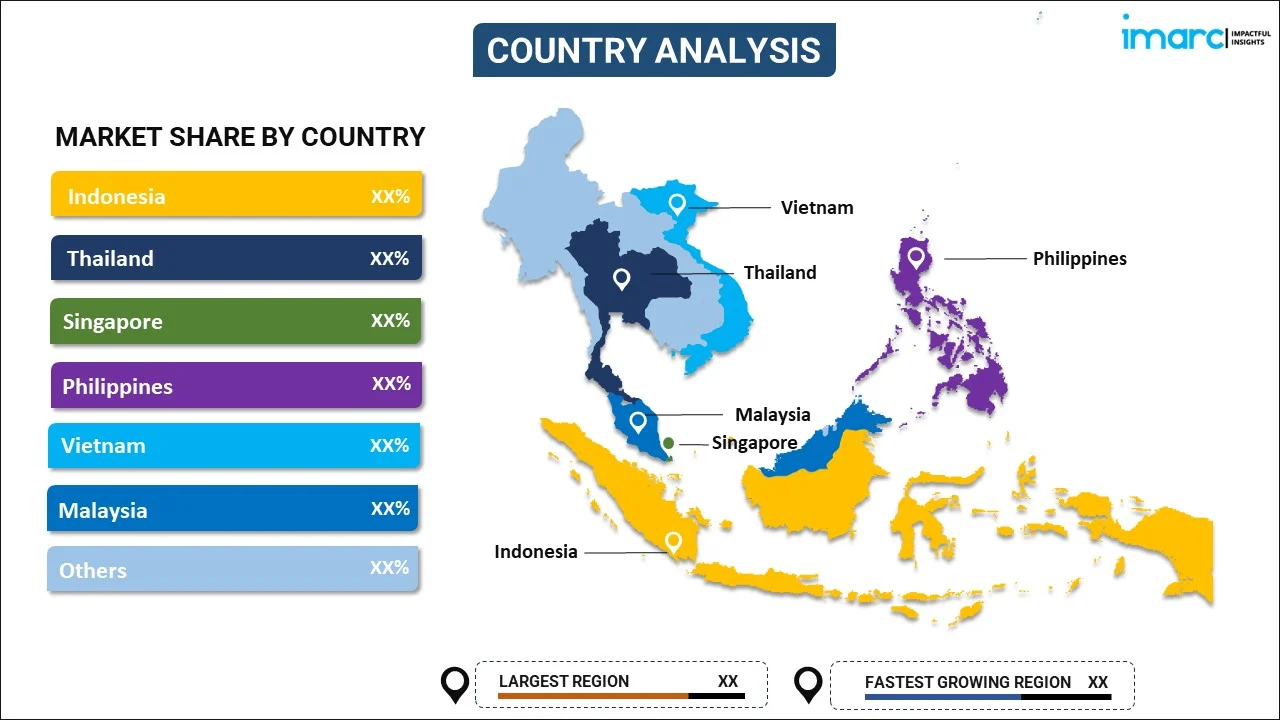
South East Asia Hydrogen Generation Market Report by Technology (Coal Gasification, Steam Methane Reforming, and Others), Systems Type (Merchant, Captive), Application (Methanol Production, Ammonia Production, Petroleum Refinery, Transportation, Power Generation, and Others), and Country 2025-2033
Market Overview:
South East Asia hydrogen generation market size reached USD 6.5 Billion in 2024. Looking forward, IMARC Group expects the market to reach USD 9.4 Billion by 2033, exhibiting a growth rate (CAGR) of 4.25% during 2025-2033. The growing focus on renewable energy to lower greenhouse gas emissions and combat environment change, rising utilization of hydrogen in the aviation industry, and increasing investments in research and development (R&D) represent some of the key factors driving the market.
|
Report Attribute
|
Key Statistics
|
|---|---|
|
Base Year
|
2024
|
|
Forecast Years
|
2025-2033
|
|
Historical Years
|
2019-2024
|
|
Market Size in 2024
|
USD 6.5 Billion |
|
Market Forecast in 2033
|
USD 9.4 Billion |
| Market Growth Rate 2025-2033 | 4.25% |
Hydrogen generation is a process of producing hydrogen gas (H2), which is a versatile and clean energy carrier. It is typically manufactured through various methods, with the most common being steam methane reforming (SMR) and electrolysis. It offers a means to store excess renewable energy, ensuring a stable energy supply. It plays a pivotal role in transitioning to a low-carbon economy by diversifying energy sources. It helps to lower greenhouse gas emissions in sectors that are not easy to electrify, including heavy industry and long-haul transportation. It offers clean and efficient energy and is used in fuel cells to generate electricity, offering a sustainable option to fossil fuels.
South East Asia Hydrogen Generation Market Trends:
At present, the rising focus on renewable energy to lower greenhouse gas emissions and combat environment change represents one of the crucial factors impelling the market growth in South East Asia. The generation of hydrogen through electrolysis, often referred to as green hydrogen, is gaining traction to store and utilize excess renewable energy, aligning with the efforts to decarbonize industries and sectors that are difficult to electrify, such as heavy industry and transportation. Additionally, the increasing emergence of hydrogen fuel cell vehicles (FCVs), which offer longer driving ranges and shorter refueling times compared to electric vehicles (EVs), is making them a viable option for various applications, including public transportation and logistics. Besides this, the growing advancements in hydrogen generation technologies, such as electrolysis, fuel cells, and hydrogen storage solutions, are making hydrogen production more efficient and cost-effective. Moreover, the rising development of hydrogen infrastructure like the establishment of hydrogen refueling stations, transport and distribution networks, and industrial facilities for hydrogen production and storage, is supporting the market growth in the region. Apart from this, increasing investments in research and development (R&D) by universities, research institutions, and private companies to improve the efficiency and cost-effectiveness of hydrogen production methods is strengthening the growth of the market. Furthermore, the growing utilization of hydrogen in the aviation industry as a potential solution for reducing emissions from air travel is offering a favorable market outlook. In addition, the rising employment of hydrogen as a clean fuel in the maritime sector is gaining traction. These developments are poised to create new opportunities for hydrogen generation in the region, catering to the specific needs of these industries. The growing awareness among the public about the importance of using clean energy and reducing carbon emissions is driving the demand for hydrogen-based solutions and facilitating the market growth.
South East Asia Hydrogen Generation Market Segmentation:
IMARC Group provides an analysis of the key trends in each segment of the market, along with forecasts at the regional and country levels for 2025-2033. Our report has categorized the market based on technology, systems type, and application.
Technology Insights:

- Coal Gasification
- Steam Methane Reforming
- Others
The report has provided a detailed breakup and analysis of the market based on the technology. This includes coal gasification, steam methane reforming, and others.
Systems Type Insights:
- Merchant
- Captive
A detailed breakup and analysis of the market based on the systems type have also been provided in the report. This includes merchant and captive.
Application Insights:
- Methanol Production
- Ammonia Production
- Petroleum Refinery
- Transportation
- Power Generation
- Others
The report has provided a detailed breakup and analysis of the market based on the application. This includes methanol production, ammonia production, petroleum refinery, transportation, power generation, and others.
Country Insights:

- Indonesia
- Thailand
- Singapore
- Philippines
- Vietnam
- Malaysia
- Others
The report has also provided a comprehensive analysis of all the major regional markets, which include Indonesia, Thailand, Singapore, Philippines, Vietnam, Malaysia, and Others.
Competitive Landscape:
The market research report has also provided a comprehensive analysis of the competitive landscape in the market. Competitive analysis such as market structure, key player positioning, top winning strategies, competitive dashboard, and company evaluation quadrant has been covered in the report. Also, detailed profiles of all major companies have been provided.
South East Asia Hydrogen Generation Market Report Coverage:
| Report Features | Details |
|---|---|
| Base Year of the Analysis | 2024 |
| Historical Period | 2019-2024 |
| Forecast Period | 2025-2033 |
| Units | Billion USD |
| Scope of the Report | Exploration of Historical and Forecast Trends, Industry Catalysts and Challenges, Segment-Wise Historical and Predictive Market Assessment:
|
| Technologies Covered | Coal Gasification, Steam Methane Reforming, Others |
| Systems Types Covered | Merchant, Captive |
| Applications Covered | Methanol Production, Ammonia Production, Petroleum Refinery, Transportation, Power Generation, Others |
| Countries Covered | Indonesia, Thailand, Singapore, Philippines, Vietnam, Malaysia, Others |
| Customization Scope | 10% Free Customization |
| Post-Sale Analyst Support | 10-12 Weeks |
| Delivery Format | PDF and Excel through Email (We can also provide the editable version of the report in PPT/Word format on special request) |
Key Questions Answered in This Report:
- How has the South East Asia hydrogen generation market performed so far and how will it perform in the coming years?
- What has been the impact of COVID-19 on the South East Asia hydrogen generation market?
- What is the breakup of the South East Asia hydrogen generation market on the basis of technology?
- What is the breakup of the South East Asia hydrogen generation market on the basis of systems type?
- What is the breakup of the South East Asia hydrogen generation market on the basis of application?
- What are the various stages in the value chain of the South East Asia hydrogen generation market?
- What are the key driving factors and challenges in the South East Asia hydrogen generation?
- What is the structure of the South East Asia hydrogen generation market and who are the key players?
- What is the degree of competition in the South East Asia hydrogen generation market?
Key Benefits for Stakeholders:
- IMARC’s industry report offers a comprehensive quantitative analysis of various market segments, historical and current market trends, market forecasts, and dynamics of the South East Asia hydrogen generation market from 2019-2033.
- The research report provides the latest information on the market drivers, challenges, and opportunities in the South East Asia hydrogen generation market.
- Porter's five forces analysis assist stakeholders in assessing the impact of new entrants, competitive rivalry, supplier power, buyer power, and the threat of substitution. It helps stakeholders to analyze the level of competition within the South East Asia hydrogen generation industry and its attractiveness.
- Competitive landscape allows stakeholders to understand their competitive environment and provides an insight into the current positions of key players in the market.
Need more help?
- Speak to our experienced analysts for insights on the current market scenarios.
- Include additional segments and countries to customize the report as per your requirement.
- Gain an unparalleled competitive advantage in your domain by understanding how to utilize the report and positively impacting your operations and revenue.
- For further assistance, please connect with our analysts.
 Inquire Before Buying
Inquire Before Buying
 Speak to an Analyst
Speak to an Analyst
 Request Brochure
Request Brochure
 Request Customization
Request Customization




.webp)




.webp)












